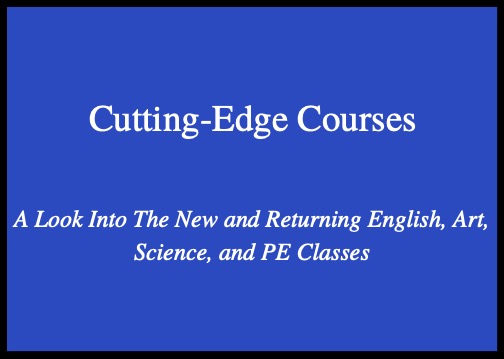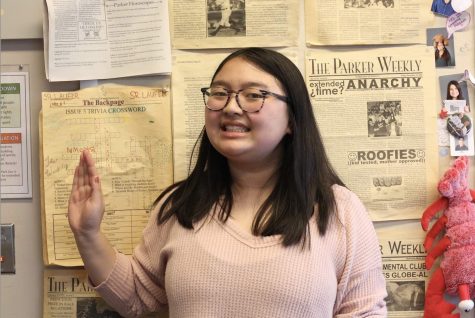Cutting-Edge Courses
A Look Into The New and Returning English, Art, Science, and PE Classes

Freshman, sophomores, and juniors gathered in the auditorium on February 28 for the annual Curriculum MX. While the course selection for most departments stayed the same, others added new classes, like “Literature of the Plague” for the English department and “Fashion & Costume Design” for the Visual Arts department. The science department brought back two fan favorites, and the PE department revamped their entire curriculum.
“The idea of having a very dynamic curriculum that’s continually evolving, it’s a lot of work for teachers. It’s a lot to create new classes to evolve existing classes. But I think it’s a labor of love that’s really about meeting students where they are,” Middle and Upper School Director of Studies Sven Carlsson said.
English teacher Mike Mahany will be teaching “Literature of the Plague,” which is only available to juniors and seniors. Students will study COVID-19 and other plagues, such as the Bubonic Plague and the AIDS epidemic. “I got to thinking that now is the time when novels about COVID or pandemics or epidemics are coming out,” Mahany said. “It got me thinking about literature just in terms of pandemics and epidemics over the course of the world. Studying that would also allow students to reflect a little bit on their experiences in the past few years.”
“Fashion & Costume Design” was inspired by visual arts teacher Kay Silva’s prior experience in costume design. “I’m most excited to work with students to learn their points of view,” Silva said over email. “Fashion/costume design is a lifelong passion of mine and I look forward to helping students create ‘wearable art’”
“Over the years we’ve had a lot of students who do a lot with fashion. We’ve seen it in cookies, we’ve seen it in side projects,” Carlsson said. “This is a thing that I think a lot of students are interested in and it’s something that requires a lot of skill and technical ability and there’s a lot to learn.” The visual art department has also changed three course titles to “Art Studio,” “Metal, Glass & Material Studies,” and “Filmmaking.”
In order to introduce a new course, teachers create a plan and have to introduce it to their department for approval. Once approved, teachers work over the summer to continue developing the course. “When you’re creating a class, there are thousands of decisions that go into everything from how you’re pacing the different activities on a given day to what order you’re putting your units in and what the units are,” Carlsson said. “It’s this very selfless but very involved process of designing something that will really be impactful and life changing and educational for students.”
“ As we start from scratch with this brand new course, I’m discovering what materials and equipment we’ll need as well as the best fashion design apps,” Silva said. “I’m having so much fun planning.”
For Mahany’s course development, he has to choose what students will read and in what order, as well as the types of assignments students will complete. “One of the things that excites me is asking students to write about how they’ve changed over the course of the last two years,” Mahany said. “Students might be really tired of talking about COVID. That’s the risk of this class. That’s kind of my worry and my excitement at the same time.”
The PE department has redesigned the majority of their courses for the 2022-23 school year. The new courses are split into “fitness electives” and “team play electives.” The fitness electives are “Box-Fit: Boxing & More,” “Intro Fit,” “Advanced Fit Training,” “Yoga Fit: Sweat, Sculpt & Stretch,” “Interval Training,” and “Mat & Mind.” The team play electives are “All About the Net,” “All About the ‘T’,” “Recreational Games,” and “World Sports.”
“We’re like, ‘what really worked during our break from in person classes?’ We revisited what we taught via Zoom and what students did to stay active when they were responsible for exercise submissions,” Physical Education teacher Jan Zoufal said.
“Interval Training” and “Mat & Mind” are returning classes. Two new classes within the fitness elective are “Intro Fit” and “Advanced Fit Training,” which were designed to accommodate students at various experience levels with working out. “We realized that there are students who are so into fitness and they know exactly what to do, but we have students who are a little intimidated about the fitness room, and want to workout,” Zoufal said.
“Yoga Fit: Sweat, Sculpt & Stretch,” is another new course title, and the PE class will serve as an extension of “Step & Strength.” “Ms. Turpin had taken over the class this year, and it was her class so she could develop in any way she wanted,” Zoufal said. “She did a variety of different things in her ‘Step & Strength’ class, and maybe she did some yoga some days, maybe she did a little cardio burst, etc., so we decided to cluster everything into that class.”
Boxing is another new class, created since many students submitted boxing workouts during remote learning. Students will learn boxing basics and “the mental aspect of a boxer,” as well as possibly attend boxing classes at Title Boxing Club during their class period.
One new team play elective is “Recreational Sports,” which will include games such as cornhole, Spikeball, and Bocce. Zoufal hopes this class will inspire students to be “active outside the walls of Parker,” and be able to play games on the beach, at family events, or during retreats.
“All About The ‘T’” is a first semester class that will include team sports starting with “T,” specifically table tennis. “All About The Net” will be offered both semesters and students will play games such as badminton and volleyball. “World Sports” is another class offered both semesters where students will play rugby, cricket, and other popular international sports.
“We really wanted to touch every personality at school this year,” Zoufal said. “We’re hoping that the changes capture our audience so you are selecting a class that best suits your personality and best suits you. We want you to be able to wake up and be happy about coming to school rather than wake up and dread ‘Ah, I got PE.’”
Teachers have the opportunity to add or change classes every year. “It doesn’t happen all the time because people don’t want to change classes every year because they learn from how they teach us the first and second or third time. But we always have the opportunity to talk about it,” Mahany said.
Though in other departments, most course names are staying the same, most teachers make changes to classes year to year. Some classes are taught by different teachers, while others differ in content. “All the classes are continually changing even when you take a class that’s the same in name,” Carlsson said. “Based on who’s in the room, and what lessons the teacher has learned over the year, and what student survey feedback is like, that class basically never is the same again.” New classes are created when enough new curriculum is developed that doesn’t fit in the current course.
According to Mahany, the English department discusses turning over classes frequently. Literature of the Plague is Mahany’s third new first semester elective in four years. “We talked about, ‘are there obvious holes in the curriculum? Are there obvious courses that students should be learning about?’” Mahany said.
New classes replace those that have lost student interest. “The sad part of having finite resources of time and teachers and students is that even when we have these classes that are really meaningful and interesting to the people in them, if the numbers aren’t enough, we then have to cycle through it because it’s not popular now,” Carlsson said.
Some of these classes make a comeback, like “Chemistry of Cooking,” and “Human Anatomy and Physiology.” “I know that my brother did Chem of Cooking and he hasn’t seen food the same ever since, and he’s more careful about what he’s eating,” junior Gabriella Watkins said. “I’m going to be able to learn a lot more about what I’m eating and putting in my body.”
“The idea of us as a progressive school is that we’re really big on understanding where students’ interests lie and having them discover their passions,” Carlsson said. “The world is clearly changing, so it makes sense for courses to do that, too.”







